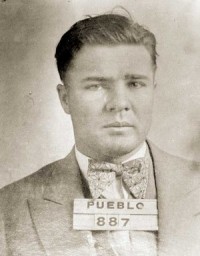10.20

This week (October 20-26) in crime history – Members of the rap group 2 Live Crew were acquitted of obscenity charges (October 20, 1990); Pretty Boy Floyd was killed by FBI agents (October 22, 1934); Dr. Barnett Slepian was shot to death by anti-abortion radicals (October 23, 1998); Chenchen rebels take 700 hostages at Moscow theater (October 23, 2002); Marv Albert was sentenced for infamous biting assault case (October 24, 1997); Susan Smith falsely claimed she was carjacked to cover-up murder of her two children (October 25, 1994); Former Secretary of Interior Albert Fall was found guilty of bribery in the Teapot Dome scandal (October 25, 1929); Shootout at the OK Corral (October 26, 1881)
Highlighted Crime Story of the Week –
On October 22, 1934, Charles “Pretty Boy” Floyd was shot and killed by FBI agents in a cornfield in East Liverpool, Ohio. Floyd, who had been a hotly pursued fugitive for four years, used his last breath to deny his involvement in the infamous Kansas City Massacre, in which four officers were shot to death at a train station. He died shortly thereafter. Floyd grew up in a small town in Oklahoma. When it became impossible to operate a small farm in the drought conditions of the late 1920s, Floyd tried his hand at bank robbery. He soon found himself in a Missouri prison for robbing a St. Louis payroll delivery. After being paroled in 1929, he learned that Jim Mills had shot his father to death. Since Mills, who had been acquitted of the charges, was never heard from or seen again, Floyd was believed to have killed him.
Moving on to Kansas City, Floyd got mixed up with the city’s burgeoning criminal community. A local prostitute gave Floyd the nickname “Pretty Boy,” which he hated. Along with a couple of friends he had met in prison, he robbed several banks in Missouri and Ohio, but was eventually caught in Ohio and sentenced to 12-15 years. On the way to prison, Floyd kicked out a window and jumped from the speeding train. He made it to Toledo, where he hooked up with Bill “The Killer” Miller. The two went on a crime spree across several states until Miller was killed in a spectacular firefight in Bowling Green, Ohio, in 1931. Once he was back in Kansas City, Floyd killed a federal agent during a raid and became a nationally known crime figure. This time he escaped to the backwoods of Oklahoma. The locals there, reeling from the Depression, were not about to turn in an Oklahoma native for robbing banks. Floyd became a Robin Hood-type figure, staying one step ahead of the law.
However, not everyone was so enamored with “Pretty Boy.” Oklahoma’s governor issued a $6,000 bounty for his arrest. On June 17, 1933, when law enforcement officials were ambushed by a machine-gun attack in a Kansas City train station while transporting criminal Frank Nash to prison, Floyd’s notoriety grew even more. Although it was not clear whether or not Floyd was responsible, both the FBI and the nation’s press pegged the crime on him. As a result, pressure was stepped up to capture the illustrious fugitive, and the FBI finally got their man in October 1934.
Michael Thomas Barry is a columnist for www.crimemagazine.com and is the author of numerous books that include the award winning Murder and Mayhem 52 Crimes that Shocked Early California, 1849-1949.











